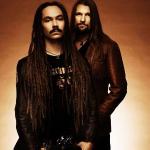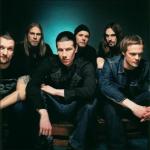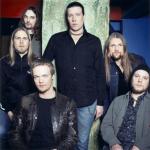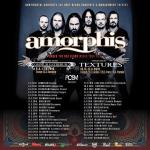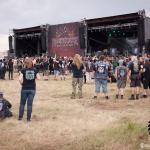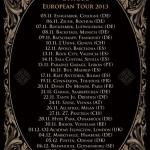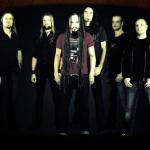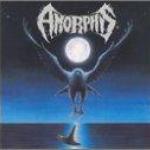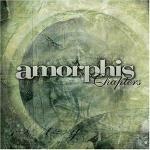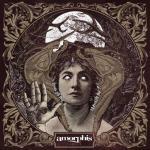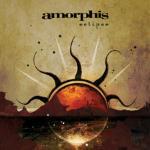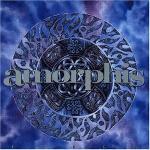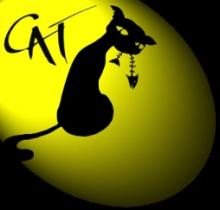Amorphis
Although The Karelian Isthmus took its name from a historic Finnish battleground, its lyrics contemplated universal themes of warfare and religion, drawing on Celtic mythology rather than the traditions of Amorphis´ own native land. With its sophomore release, however, the group reclaimed its Finnish heritage in triumph, creating a monumental album that single-handedly put the small Nordic country on the map of progressive metal and is nowadays considered an all-time classic: Tales from the Thousand Lakes, a concept album based on the Finnish national epic, the Kalevala. While still strongly rooted in the death metal tradition, this 1994 release already branched out beyond the usual confinements of the genre. The boldest step toward a new direction was the addition of clean vocals, provided by Kyyria´s Ville Tuomi. Ville´s melodic voice, elegantly contrasting with Tomi´s growls, brought a new dimension to the band´s sound, as did the greater prominence of synthesizer and piano. Whereas the synth tracks on the first album had been laid down by drummer Jan, Amorphis had recently found a full-time keyboard player in Kasper MŒrtenson. Kasper´s best-known contribution to the band´s repertoire was the song "Black Winter Day", which was later released on an EP (flanked by outtakes from the Tales sessions) and remains a favorite among old and new fans alike.
The success of Tales was immediate and overwhelming. The ensuing tours and tough schedules, however, took their toll, and Kasper soon decided to leave the band. A successor was found in Kim Rantala. Jan was replaced by Pekka Kasari (ex-Stone), and just before recording their third album, Amorphis recruited a sixth member, singer Pasi Koskinen. With this new line-up, the band boldly launched into its most adventurous endeavor yet. Elegy (1996) became a quantum leap for Amorphis, the watershed between their death/doom beginnings and the unique brand of progressive rock that has been the cornerstone of their albums ever since. Without doubt, Elegy was still a metal album, and a highly acclaimed one at that, yet there was a lot more to it. Its songs were not even based on guitar riffs anymore but on pure melody, often with a distinct Eastern touch. The mesmerizing interplay between Kim´s lush synthesizer arabesques and Esa´s immaculate guitar lines conjured up the spirit of 1970s progressive rock at its finest. Lyrics were again adapted from Finnish mythology, in this case, the Kanteletar, a collection of ancient folk poetry. Pasi and Tomi shared the vocals on a roughly equal basis, with Pasi´s role restricted to the clean parts. To demonstrate the band´s increasing versatility, an acoustic version of Elegy´s perhaps most significant song, "My Kantele", was added as a reprise at the end of the album. This acoustic rendition also served as the title track of the next EP, released in 1997, which contained two new originals as well as two excellent cover versions of songs by Hawkwind and Finland´s own heroes of oriental-flavored psychedelia, the legendary Kingston Wall. After about one and a half years of extensive touring following the release of Elegy, the band members opted for a time-out to recharge their batteries and think about new material. From the outset it was clear that the next album would have to do without the extensive production of Elegy and strive for an earthier, less meandering feel. This decision was in part due to the fact that the band was again without a keyboardist after losing sight of ever-busy Kim. Toward the end of the studio sessions, Santeri Kallio of Kyyria was brought in to add some tasteful keyboard tracks to the songs, but first and foremost, 1999´s Tuonela was a guitar album. Its mellow, understated beauty displayed the maturity of a band that had fully come into its own, making music for the sheer joy of playing a good song without wasting a thought on categories. Even the album´s one "pure" metal track, "Greed", was playfully introduced by an Indian-style melody, performed by Tomi on sitar. Other foreign spices were provided by saxophonist/flutist Sakari Kukko of world music legend Piirpauke. The guitar parts were honed to perfection, often reminiscent of Pink Floyd or U2 in their extensive yet sophisticated use of delay effects. All vocals including the few remaining grunts were now performed by Pasi, who had also written almost all of the lyrics. With hindsight, Tuonela may be considered the most focused (and, to new initiates, most easily accessible) among Amorphis´ albums, each of its ten songs a timeless gem in its own right yet forged smoothly together into a coherent whole greater than the sum of its parts.
The new millennium was greeted with the tenth-anniversary compilation Story and another line-up change. Following the breakup of Kyyria, Santeri had already joined Amorphis as a full-time member when bassist Oppu felt he could no longer commit himself to the band. He was succeeded by another ex-Kyyria member, Niclas EtelŠvuori, who came in just in time for Amorphis´ third U.S. tour. Back home in Finland, the studio beckoned again. Am Universum, released in 2001, retained the moody atmosphere of Tuonela but introduced more varied soundscapes and a much wider dynamic range. Instead of letting the guitars dominate throughout, more space was given to keyboards and saxophone work, the latter again masterfully contributed by Sakari Kukko. The folk influences took a step back on Am Universum in favor of a more experimental approach, allowing for liberated studio jams. In the literal sense of the word rather than in purely musical terms, this was Amorphis´ most psychedelic – that is, soul-baring offering to date, not in the least due to Pasi´s increased confidence as a lyricist and singer. The opening track "Alone", a quintessential Amorphis song, was released as a single and topped the Finnish charts for three weeks. In 2002 the band was asked for a contribution to the soundtrack for the movie Menolippu Mombasaan. The commissioned piece was a cover version of a 1976 Finnish pop hit, "Kuusamo", which was given the full Amorphis treatment and remains the band´s only song in their native tongue to this day.
Amorphis´ longstanding relationship with Relapse Records ended with Am Universum. In 2003, Relapse released the retrospective Chapters, which included a DVD featuring the band´s videos from "Black Winter Day" to "Alone". Freed from a contract whose smallprint had not always been in their best interests, the band members decided to record the next album on their own terms and shop for a label with the finished product in hand. Far From The Sun was produced by the band itself, which had been rejoined by original drummer Jan Rechberger after Pekka Kasari had quit to concentrate on family duties. Recording most of the tracks at Niclas´ and Santeri´s own CCPC studio obviously added to the relaxed and intimate feeling of this album. Involving no guest performances apart from some background vocals, it came closer to Amorphis´ live sound than any of their previous recordings did. Compared to Am Universum, Far From The Sun turned out heavier, more straightforward and also once again more folk-oriented, journeying deep into Turkish and Persian territory. The album was released by Virgin/EMI in the spring of 2003, but only in Europe. The US release had to wait until the fall of 2004 and would have been accompanied by a North American tour, had not fate stepped in. The tour itself was ultimately canceled for reasons beyond the control of the band, yet the prospect of it gave Pasi, father of two small children and involved in numerous other musical projects, the reason he had been looking for to leave the band after nine years.
The search for a new frontman proved no easy task. Of more than a hundred demos submitted by hopeful candidates, not one fit the criteria. In the end, Amorphis found the right person through word of mouth: Tomi Joutsen (Sinisthra), a powerful, multi-faceted singer with breathtaking on-stage charisma. His intense, deeply emotional delivery immediately won the crowds over at each concert the band gave in 2005, including a one-month tour of North America. Himself a fan of Amorphis since their early days, Tomi brought not only new vigor and a fresh perspective to the band but also the initiative to revive the use of contrasting vocal styles that had contributed so much to the magic of Elegy and Tales. In line with this choice, the band, which by then had signed with its trusted partner of old, Nuclear Blast, decided to reconnect with the past on another, even more surprising level when agreeing on a concept for the new album. With Eclipse (2006), Amorphis once more turned to the Kalevala for inspiration, this time retelling the tragic fate of Kullervo. The vast dramatic scope of the ancient tale provided the canvas for Amorphis to paint an all-encompassing masterpiece. Summoning the best ingredients from their rich past while again reveling in the undiminished joy of experimenting with fresh elements, the band succeeded in creating their most versatile album to date. With their strongest line-up ever, Amorphis are ready to conquer new ground yet again ânever confining their style to any definite shape, yet always instantly recognizable, always true to their own vision, and always unique.
Quelle: http://www.amorphis.net/Discografie1992 The Karelian Isthmus
1993 Privilege of Evil
1994 Tales Of The Thousend Lakes
1995 Black Winter Day
1996 Elegy
1997 My Kantele
1999 Tuonela
2001 Am Universum
2003 Far From The Sun
2006 Eclipse
www


